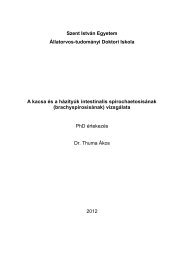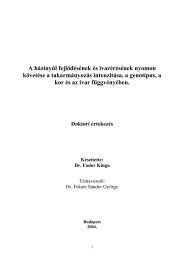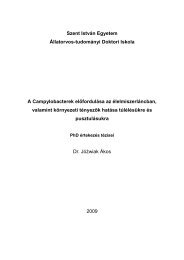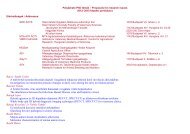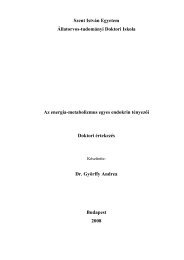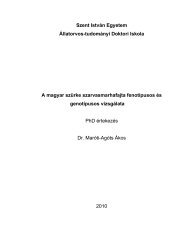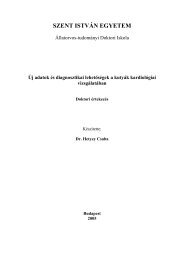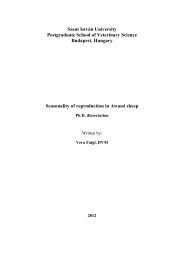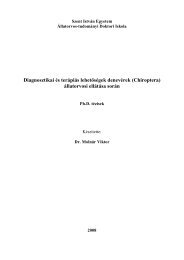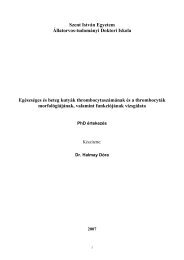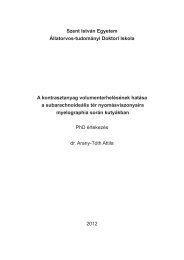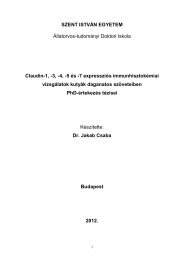Mándoki - Állatorvostudományi Doktori Iskola - Szent István ...
Mándoki - Állatorvostudományi Doktori Iskola - Szent István ...
Mándoki - Állatorvostudományi Doktori Iskola - Szent István ...
Create successful ePaper yourself
Turn your PDF publications into a flip-book with our unique Google optimized e-Paper software.
12. SUMMARY<br />
Avian nephritis (AN) is a widely distributed viral kidney disease of newly hatched<br />
chickens resulting in well recognizable macroscopic lesions. Poultry is prone to develop<br />
uricosis, so it is often diagnosed as cause of death. There are several non-infectious and also<br />
infectious causes classified in the aetiology of uricosis. PM examination of young chickens<br />
sent to the Department of Pathology and Forensic Veterinary Medicine indicated that the<br />
diagnosed tubulonephrosis and interstitial nephritis might be of viral origin, most probably<br />
ANV. As any condition which results in nephropathy and renal failure leads to gout, the<br />
differential diagnosis of ANV became essential. The aim of this thesis work was to prove the<br />
presence of the avian nephritis virus in Hungary and to develop a fast and reliable method to<br />
diagnose ANV in samples sent to our laboratory from different farms experiencing high<br />
losses.<br />
In order to detect Avian Nephritis Virus (ANV), kidney samples from chickens<br />
diagnosed with acute nephritis and gout were subjected to histopathologic and electron<br />
microscopic examination. The EM examination revealed the presence of small round, non-<br />
enveloped virions of 28-31 nm in diameter in the tubular epithelial cells with the<br />
characteristic five-pointed or six-pointed star-like morphology of the icosahedral capsid.<br />
ANV-specific primer pairs were designed on the 5’ non-structural region of the<br />
reference strain (GeneBank accession number NC_003790). An RT-PCR assay followed by a<br />
nested reaction was developed. After the optimalization of the PCR reaction on the reference<br />
strain, other kidney samples were also screened. The reactions resulted in distinct products<br />
with the previously calculated size, 816bp after the RT-PCR and 325bp after the nested RT-<br />
PCR reaction. The nucleotide sequence of the 816bp long amplicon was determined. It has<br />
shown the highest identity with the nucleotide sequence of the targeted genome region of<br />
ANV in BLAST search. The sequence was aligned with the complete ANV genome,<br />
exhibiting 92% identity between the Hungarian genotype and the GP1 genome section of the<br />
reference virus strain.<br />
Between 2002 and 2005 numerous kidney and intestine samples were collected from<br />
chickens of different age from different Hungarian flocks showing the special pathological<br />
changes. The samples were pooled for screening or stored individually for particular organ<br />
examinations, then homogenized for subsequent RNA extraction/purification. The PCR<br />
resulted in a detection of a specific product in several samples from Hungarian flocks.<br />
82



